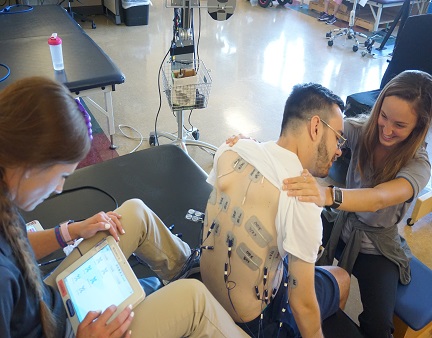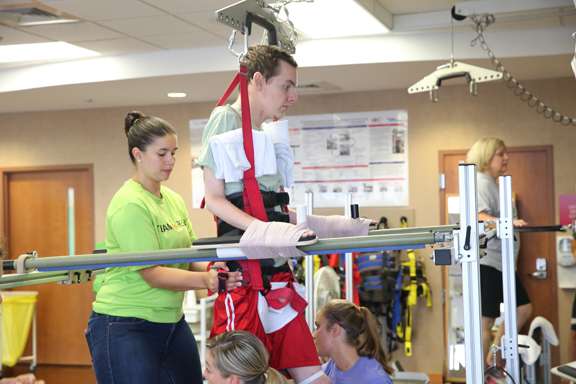Scientific Director

Charles Hubscher, PhD
|
|
|
The Team
|
Research Manager

Terri Manning
|
Research Manager

Brittany Logsdon
|
Research Nurse

Kristen Johnson, RN, BSN
|
C.O.R.E.
Comprehensive
The Urogenital and Bowel Scientific Core takes a comprehensive approach to the care and study of issues related to bladder, bowel, or sexual dysfunction in individuals with spinal cord injuries. We work collaboratively across multi-disciplinary research and clinical teams that include experts in neurology, gastroenterology, neurosurgery, and rehabilitative services, so we can provide optimal care for our research participants. Our scientists and clinicians have experience working with individuals with spinal cord injuries and we combine excellent clinical care with scientific expertise in a compassionate environment.
Objective
We design protocols using standard medical and research equipment to obtain objective assessments of urogenital and bowel functions. These assessments are essential to helping us better understand, improve and ultimately overcome dysfunction in these areas.
Bladder Function Assessments
- Questionnaire: adapted from an internationally accepted standardized questionnaire (Biering-Sorensen et al. (2018) Spinal Cord Ser Cases. 2018 Jul 6;4:60-Version 2) our Bladder Function Questionnaire is used to assess overall bladder health and management.
- Bladder Diary: an individual’s record of liquid intake and urine output provides valuable insight into kidney and bladder function and use of our Bladder Diary complements our lab-based assessments.
- Uroflowmetry: Measures the amount of urine emptied during urination as well as the speed (rate) and pattern (constant, interrupted) of urination.
- Cystometrogram (CMG): measures the size of your bladder (how much fluid your bladder can hold) and how full the bladder is when you begin to feel the need to urinate. It also records the pressure inside the bladder during bladder filling and emptying.
- Electromyography (EMG): small sensors are used to measure the strength and electrical activity of muscles and nerves in and around the bladder and sphincters (the pelvic floor).
- Bladder and Kidney Ultrasound: a noninvasive technique that transmits sound waves through the body; images of the bladder and kidneys help to assess damage from chronic high pressure in the bladder and potential backflow of urine into the kidneys (urinary reflux).
Bowel Function Assessments
- Questionnaire: adapted from an internationally accepted standardized questionnaire (Krogh et al. (2017) Spinal Cord 55: 692–698-Version 2) our Bowel Function Questionnaire is used to assess overall bowel health and management of fecal elimination.
- Anorectal Manometry (ARM): evaluates bowel function in individuals that have difficulty with constipation and/or experience stool leakage. It measures the strength of the anal sphincter muscles, sensation in the rectum as well as the neural reflexes necessary for bowel movements.
Sexual Function Assessments
- Questionnaires: standardized questionnaires are used to assess overall sexual health and management in both Males (adapted from Rosen, R. et al. (2006) Urology 68 (Suppl 3A): 6-16 and Alexander, M. et al. (2011) Spinal Cord 49: 795-798) and Females (adapted from Alexander, M. et al. (2009) The Journal of Spinal Cord Medicine 32 (3): 226-236 and Alexander, M. et al. (2011) Spinal Cord 49: 787-790).
What to Expect During Testing
- Our experienced nurses perform assessments in private, dedicated evaluation rooms.
- Any special preparations or requirements, such as stopping certain medication, is communicated prior to testing.
- A medical history interview and physical exam are performed prior to any testing.
- Blood pressure and heart rate are monitored throughout any testing.
Research-driven
We employ a “Discovery-to-Recovery” approach and work closely across disciplines to expand knowledge and bring innovative treatments to practice so that individuals with spinal cord injuries can experience their own personal Victory Over Paralysis. Our work is published in leading scientific journals.
See our Most Recent Articles.

Photo source: Shaoping Hou, Alexander G. Rabchevsky. Autonomic Consequences of Spinal Cord Injury. Compr Physiol 2014, 4: 1419-1453.
Evidence-based
The majority of individuals with spinal cord injury experience autonomic dysfunction that impacts the urogenital and bowel systems. The assessments we perform are leading to a greater understanding of how interventions such as Locomotor Training (LT), Neuromuscular Electrical Stimulation (NMES) and spinal cord Epidural Stimulation (scES) have helped individuals with spinal cord injuries regain function and improve their quality-of-life. |
Adult NeuroRecovery
Translational Cores
Metabolic, Neuromuscular, and Skeletal
Cardiovascular and Pulmonary
Movement Performance and Locomotor Recovery
Urogenital and Bowel
Neurophysiology
Engineering
Research Medical
Biostatistics, Outcomes, Database, and Communications
Finance and Administrative
Movement Performance and Locomotor Recovery Clinic
Investigators
|










